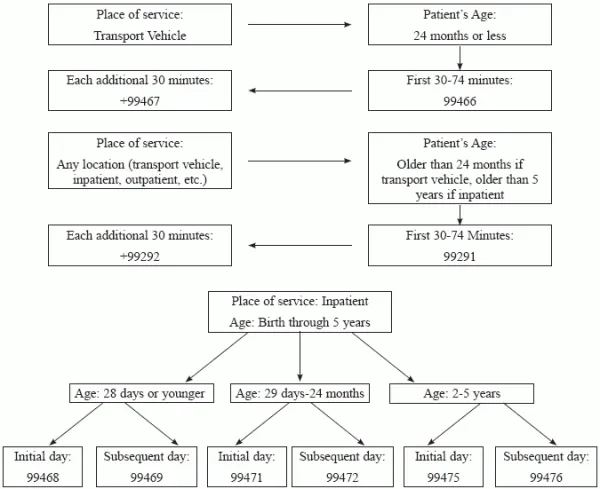Pinpoint Accurate Critical Care Codes Every Time With 5 Quick Tips
Yes, you can administer critical care in the ED. As most ED coders know, critical care services don't just take place in the hospital's ICU unit-they often occur right in your emergency department, and you must know the rules to code these services properly. Read on for five frequently-asked questions about critical care coding, along with the expert answers. FAQ 1: How Can You Demonstrate the Need for Critical Care? Whether the patient was critically ill or injured is perhaps the most important question you'll need to answer on any critical care claim. You must be able to establish that the patient is critically ill or injured to report 99291 (Critical care, evaluation and management of the critically ill or critically injured patient; first 30-74 minutes) or +99292 (... each additional 30 minutes [List separately in addition to code for primary service]). CPT® defines critically ill or injured as "an injury or illness that acutely impairs one or more vital organ systems such that there is high probability of imminent or life-threatening deterioration in the patient's condition." The imminent threat of permanent harm can be to life or organ system, such as circulatory failure or respiratory failure. In addition, minimal time thresholds of care, at least 30 minutes, must be clear from the medical records. It is also important to note that the provider who is reporting critical care time should be taking care of the issue that qualifies as the critical illness or injury. FAQ 2: Where Can the Physician Provide Critical Care? Place of service for critical care when reporting 99291-99292 is not restricted in CPT® or based on CMS rules, other than to identify typical areas of a facility where it may occur. While most critical care will occur in a critical care area (ICU, ED, etc.), the physician can bill 99291 for services performed in any place of service the patient requiring it presents. Providing critical care services is based on patient's condition and the acuity of the service being provided. A patient being monitored in an intensive care unit but whose organ systems are in stable condition may not meet the criteria for critical care services. In contrast, a patient in respiratory failure in your ED may require critical care services even though the patient has not yet been admitted to the hospital. FAQ 3: What's Bundled Into the Critical Care Codes? The CPT® critical care preamble includes a specific list of services bundled in to code 99291 that you should not report separately. These include: Bottom line: When your physician provides any of the above services during a critical care session, do not report them separately. Non-bundles: You can report the below services separately from 99291 and +99292, as CPT® does not bundle them into critical care: Be sure that the documentation indicates the critical care time is not inclusive of any separately billable procedure time. This will assist in distinguishing the separateness of each service, and supporting non-overlapping time. FAQ 4: Is It 30 or 31 Minutes to Qualify For Critical Care? Although the rule of thumb is that you must exceed the published midpoint to report any time-based code, in the case of code 99291, you'll find specific language in CPT® that states that 30 minutes of critical care is required, although the time need not be continuous. However, that doesn't mean that you can tack on a unit of +99292 if the physician sees a critical care patient for an hour. The reason is that even though the minimum threshold for reporting 99291 is 30 minutes, that code covers any critical care service from 30-74 minutes. Therefore, you shouldn't add a unit of +99292 unless the critical care service spans 75 or more minutes. FAQ 5: Do the Codes Differ for Pediatric Patients? The answer will depend on the place of service. In the ED, you should report 99291 and possibly 99292 for your pediatric patients. However, if you're reporting critical care services for inpatient pediatric patients, some of the claims will require pediatric critical care codes 99468 (Initial inpatient neonatal critical care, per day, for the evaluation and management of a critically ill neonate, 28 days of age or younger) through 99471 (Initial inpatient pediatric critical care, per day, for the evaluation and management of a critically ill infant or young child, 29 days through 25 months of age). It is important to note that code describes the full day rather than by the hour as described by 99291 That's why the work RVUs is 18.46 for inpatient neonatal critical care and 15.98 for 99471 (Initial inpatient pediatric critical care, per day, for the evaluation and management of a critically ill infant or young child, 2 through 5 years of age) rather than the 4.50 work RVU assigned to 99291. Even in the inpatient pediatric setting, if the patient is six years or older, you'll revert to "adult" critical care codes 99291-99292. You need to remember, however, that the patient must still meet the parameters for critical care in order to report 99468-99476. The same clinical definition for critical care services apply to the adult, child, and neonate. The variability is the time threshold per age; per day versus per hour. Please note than the attending group of record will report the pediatric critical care codes; critical care services provided by a second individual of a different specialty not reporting a per-day neonatal or pediatric critical care code can be reported with 99291 or 99292. Clip This Chart and Save It for Quick Critical Care Guidance Tie together all the facts that you've learned about critical care coding in this issue by clipping this handy chart and hanging it somewhere in your office. The chart can guide you as you determine which code applies to your critical care services. Keep in mind: When reporting the neonatal or pediatric critical care codes, the primary physician reports the pediatric or neonatal critical care codes, while the second specialist would report 99291 or 99292. In addition, heed the new language in the 2018 CPT® book: Previously, language restricted users from reporting critical care services by individuals from the same group.



.webp)

